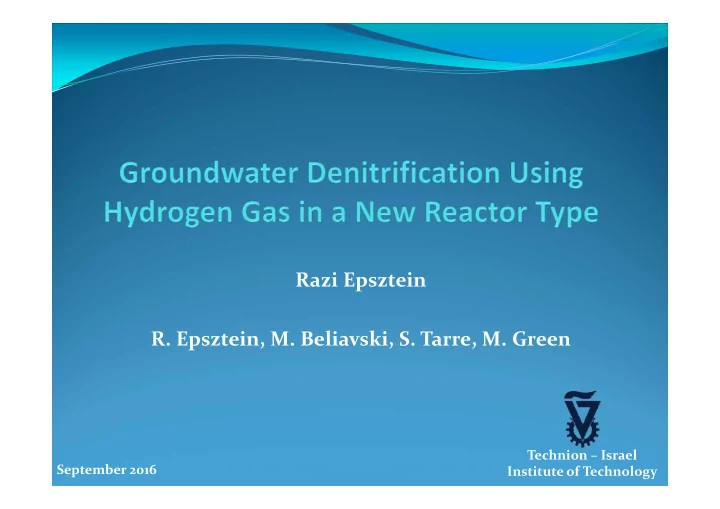

Razi Epsztein R. Epsztein, M. Beliavski, S. Tarre, M. Green Technion – Israel September 2016 Institute of Technology
Short background Nitrate pollution (>10 mg NO3 ‐ ‐ N/L according to EPA) Physicochemical methods (RO, IEX, Electrodialysis) Biological denitrification: Nitrate reduction to N 2 gas by denitrifying bacteria under anoxic conditions. Electron donor can be organic or inorganic and must be added to water. Cell Yields are lower for autotrophic bacteria using inorganic electron donors (30% of heterotrophs). 2
Hydrogenotrophic denitrification Why hydrogen? Clean: Low cell yield, no organics addition, no harmful by ‐ products Does not persist in water Cheap So why not ? Mass transfer limitations ‐ > low rates Low hydrogen utilization ‐ > financial aspects Hydrogen flammability/explosiveness ‐ > safety aspects 3
How can hydrogen transfer be increased economically and safely? Effluent One possible solution: Membrane biofilm reactor (MBFR) Lee & Rittman, 2002 Denitrification rates < 1 g N /(L reactor x day) Influent Our alternative solution: A new reactor type with closed headspace!!! 4
The common misconception of closed headspace denitrifying reactor N 2 pressure increases H 2 pressure decreases Denitrfication rate decreases Purging with H 2 is required Safety problem Financial problem 5
N accumulation in closed headspace – 2 does it really happen??? 2,5 At 20 ˚ C Developed N 2 pressure 2 1,5 Henry’s law: [bars] P = H x C 1 H [bar * L / mg] 0,5 0 0 5 10 15 20 25 Removed NO 3 - -N [mg/L] 35 15 20 25 30 40 N 2 [mg/L] NO 3 ‐ N: 25 mg/L NO 3 ‐ N: 25 mg/L NO 3 ‐ N: 25 mg/L NO 3 ‐ N: 10 mg/L N 2 : 15 mg/L N 2 : 30 mg/L N 2 : 15 mg/L N 2 : 15 mg/L
Our proposed system Unsaturated ‐ flow pressurized reactor Main Characteristics: - Closed Headspace (economic and safe) - High surface area for bacterial growth - High mass transfer - No N 2 accumulation under continuous operation 7
Proof of concept with GC analysis Reaching gas ‐ liquid equilibrium 2,5 Influent: 25 mg N/L Effluent: 10 mg N/L Total pressure: 3 bars 2 Partial pressure [bars] Steady state 1,5 H2 1 N2 0,5 0 0 20 40 60 80 100 120 Time [hours] H2 utilization > 90% Max. denitrification rate ≈ 9 g N/(L reactor ∙ d) 8
Summary Main features of the pressurized reactor: High H 2 utilization (>90%) Safe operation High denitrification rates (up to 9 gN/[L reactor x day]) Competitive alternative to existing technologies due to simplicity and higher rates. Future improvements: increasing H 2 utilization, treatment of water with high nitrate concentration 9
Thank you! 10
Recommend
More recommend